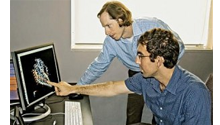 CUDA Spotlight: Molecular Research and GPUs Read more CUDA in Action Spotlights Joshua Adelman is more than your average student. He’s studying biological phenomena to better understand common diseases such as diabetes and epilepsy, leveraging the computational power of GPUs. We recently discovered his work through the Grabe Lab at the University of Pittsburgh, and were particularly interested when we learned he’s funding his project through peer-reviewed, “crowd-source” funding organization, FundScience. We caught up with Joshua, and had a chance to interview him to learn more: NVIDIA: Joshua, tell us about your research. NVIDIA: How are you leveraging GPU computing? NVIDIA: What kind of results are you seeing? NVIDIA: Tell us about how your project is funded. NVIDIA: Who are some of your contributors and partners? NVIDIA: How can people learn more about your research and how to donate? To read more about Joshua, see this recent article in Chemical and Engineering News. |